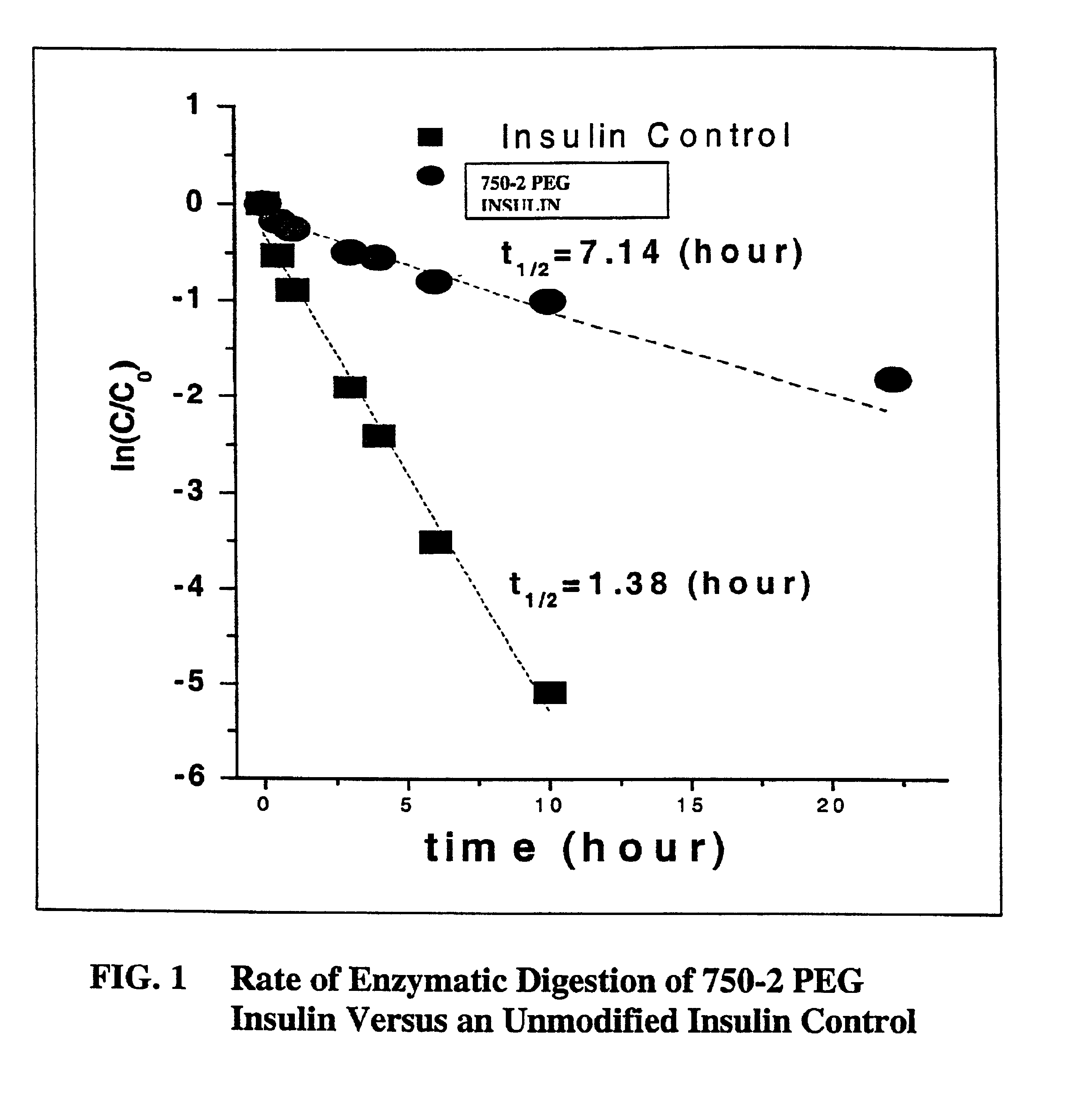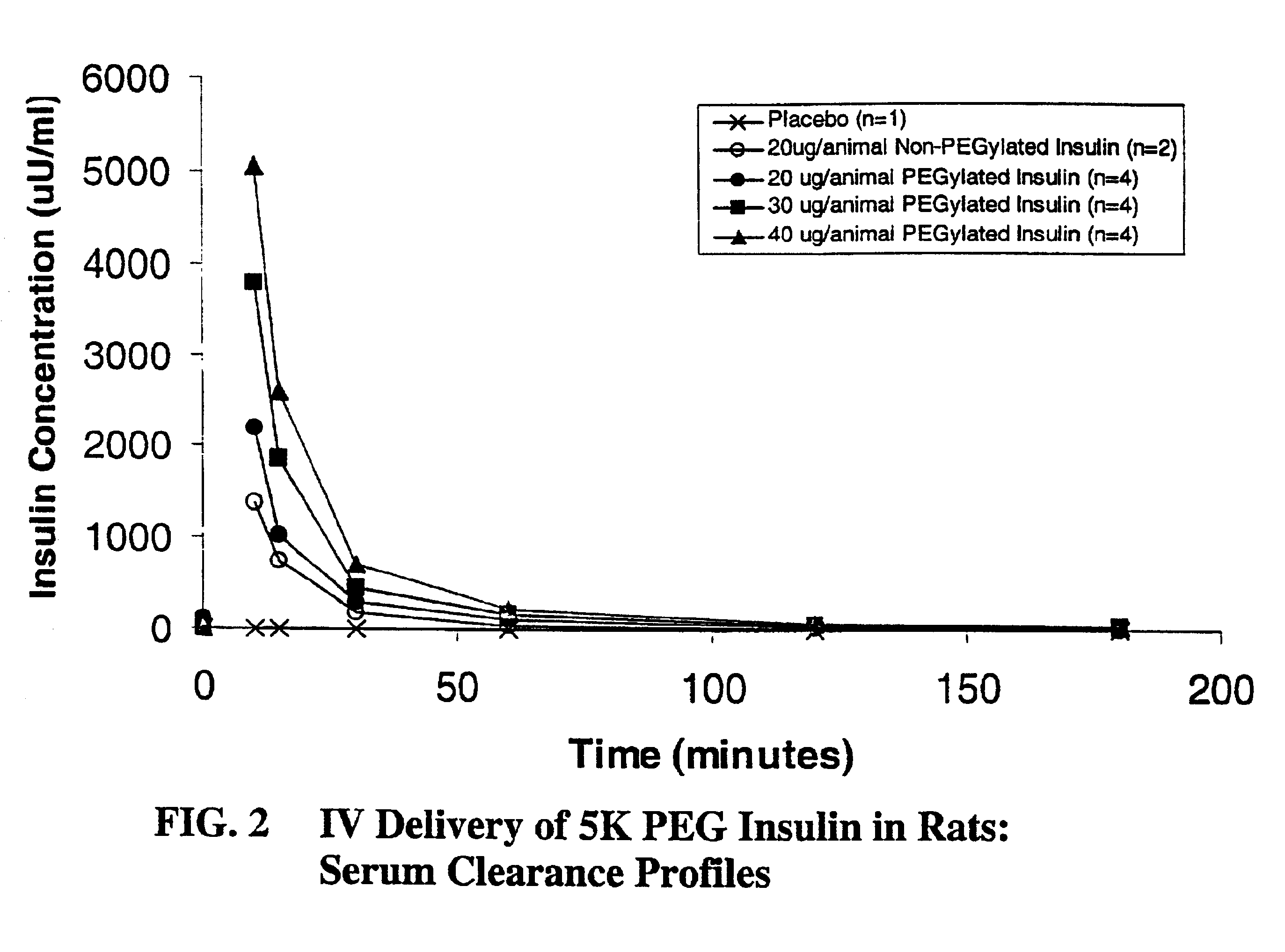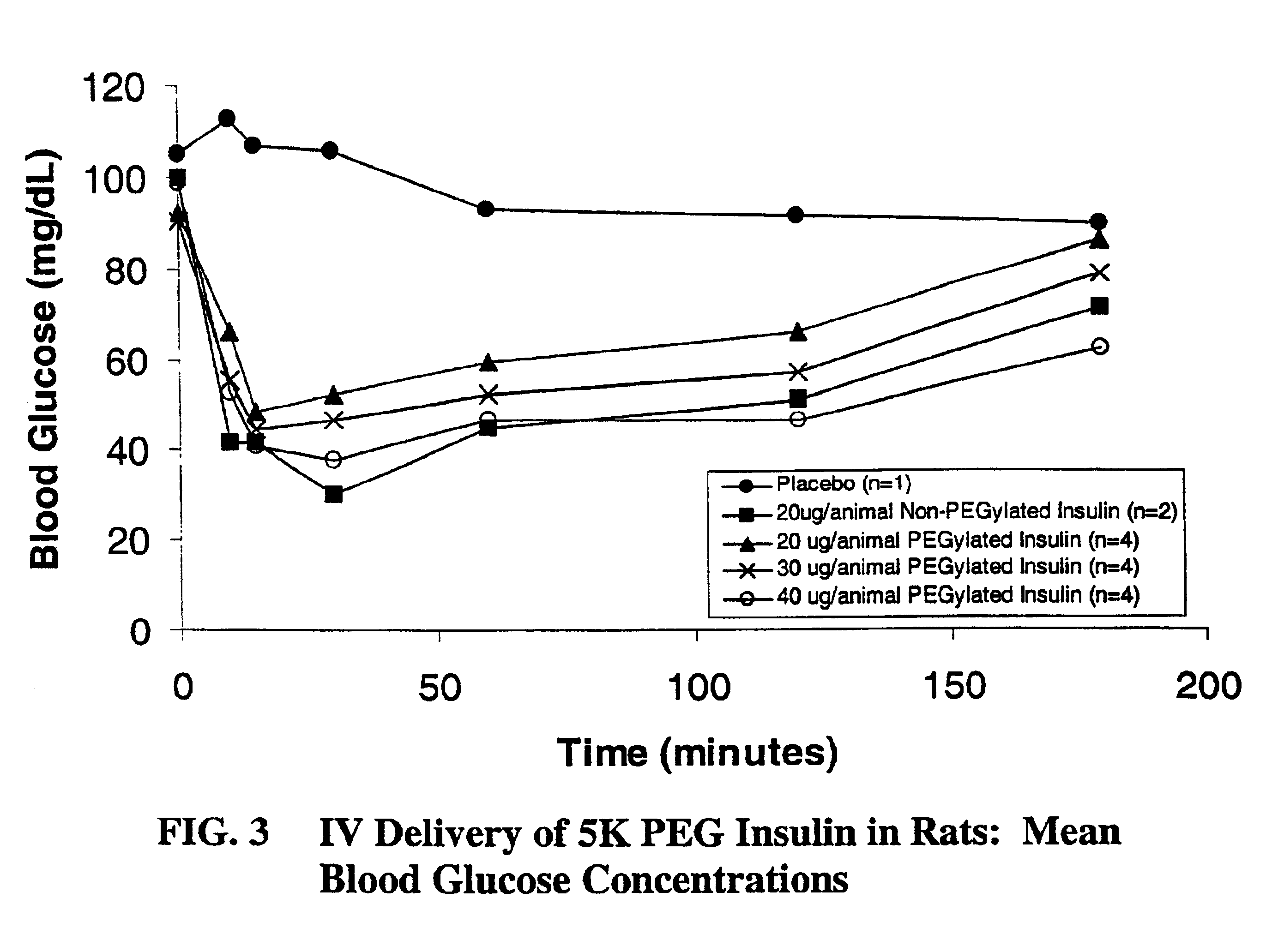Pulmonary administration of chemically modified insulin
a technology of chemically modified insulin and pulmonary administration, which is applied in the direction of aerosol delivery, peptide/protein ingredients, and metabolic disorders, etc., can solve the problems of high blood insulin levels, severe medical complications in the treatment of diabetes, and insulin formulations that also suffer from physical instability, etc., and achieve the effect of increasing insulin blood levels
- Summary
- Abstract
- Description
- Claims
- Application Information
AI Technical Summary
Benefits of technology
Problems solved by technology
Method used
Image
Examples
example 1
Synthesis of Di-NαA1,NεB29-t-Boc-Insulin
A composition composed primarily of mono-pegylated insulin was prepared in a site-specific fashion as set forth in Examples 1 and 2 using an exemplary linear 5,000 Dalton polyethylene glycol.
Di-protected insulin was first prepared as follows. 602 mg of human insulin (0.103 mmol) was dissolved in 3.0 mL of anhydrous dimethyl sulfoxide (DMSO) containing 166 uL of triethylamine. 50□1 of di-tert-butyldicarbonate (0.215 mmol) was added to the insulin solution. After 60 min at room temperature, the reaction solution was poured into 240 mL of acetone followed by addition of 3 drops of 6 M HCl to initiate flocculation. The precipitate was isolated by filtration, and dried in vacuo. The reaction product was purified by preparative HPLC using a Waters 25×100 mm C18 column (mean particle size, 15 μm; pore size, 100A). Mixtures of acetonitrile and 0.1%TFA in deionized water were used as eluents at a rate of 3.0 mL / min. The product was collected, distilled...
example 2
Synthesis of Mono-Pegylated mPEG-5K-SPA-PheB1-Insulin Conjugate NαBI-Methoxypoly(ethylene glycol)5K-insulin (mPEG5K-PheB1-insulin)
150 mg (˜0.025 mmol) of newly purified di-NαA1, NεB29-t-boc-Insulin from Example 1 was dissolved in 4 mL of DMSO containing 95 μL of triethylamine. 169 mg (0.032 mmol) of mPEG-SPA-5000 (mPEG-succinimidyl propionate, mPEG-O-CH 2CH2C(O)O-succinimide, MW 5,000) was added to the insulin solution. After incubation overnight (29 hours) at room temperature, the resulting mPEG-insulin derivative was diluted to 100 mL with D.I. water, dialyzed against D.I. water for 4 hours and then lyophilized. The lyophilized product was re-dissolved in 4 mL of anhydrous TFA and maintained under N2 at 0° C. for 1.5 hours to remove the Boc protecting groups. The deprotected mPEG-insulin was diluted to 50 mL with D.I. water and dialyzed against 0.1% NH4HCO3 and D.I. water overnight. Lyophilization of the product yielded a white powder. Yield was 117.6 mg (41.6%, MW˜11311.6 by MALD...
example 3
Synthesis of mPEG-2K-SPA-Insulin Conjugate
The following approach was utilized to prepare insulin pegylated in a non-site specific (i.e., random) fashion utilizing an exemplary linear polyethylene glycol having a molecular weight of approximately 2,000 Daltons. 0.1012 g of insulin (MW 5826 Da, 0.01737 mmol) was dissolved in 0.5 mL of anhydrous DMSO and treated with 50 μL of triethylamine (0.3587 mmol, 20 fold molar excess). To the above reaction mixture was added 52 mg of m-SPA-2000 (mPEG-succinimidyl propionate, Shearwater Corporation, MW˜2000 Da, 0.02605 mmol, 1.5 fold molar excess). The mixture was stirred for about 17 hours at room temperature under nitrogen. The reaction mixture was then dissolved in 0.1% TFA to a total volume of 5.5 mL and purified by reverse phase IHPLC using a C-18 column, and acetonitrile / 0.1%TFA as eluent). Reverse phase HPLC revealed a mixture of both mono (one PEG attached) and di-pegylated (two PEGs attached) product; the composition is referred to herei...
PUM
| Property | Measurement | Unit |
|---|---|---|
| molecular weight | aaaaa | aaaaa |
| molecular weight | aaaaa | aaaaa |
| molecular weight | aaaaa | aaaaa |
Abstract
Description
Claims
Application Information
 Login to View More
Login to View More - R&D
- Intellectual Property
- Life Sciences
- Materials
- Tech Scout
- Unparalleled Data Quality
- Higher Quality Content
- 60% Fewer Hallucinations
Browse by: Latest US Patents, China's latest patents, Technical Efficacy Thesaurus, Application Domain, Technology Topic, Popular Technical Reports.
© 2025 PatSnap. All rights reserved.Legal|Privacy policy|Modern Slavery Act Transparency Statement|Sitemap|About US| Contact US: help@patsnap.com



